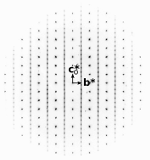

Since the discovery of X-ray diffraction by Max von Laue 100 years ago, it has been generally accepted that crystalline materials are periodic in three dimensions, i.e. possess a three dimensional translation lattice. Yet, already in the first years of systematic crystal structure solution from X-ray difraction data in the 1950ies, it was noted that nature does not obey these dogmatic rules.
Indeed, crystals of the chain-silicate mineral wollastonite and related chain-phosphate and -arsenate phases do not possess long range order (and therefore no translational symmetry) in all spacial directions and yet follow a strict building principle. These compounds were instrumental in the development of Order/Disorder (OD) theory, which is a generalization of common crystallography with emphasis on local symmetry. Over the course of the following decades a plethora of OD-structures in all classes of compounds, from inorganics to bio-macromolecules were discovered, demonstrating the generality of the OD-principle.
Surprisingly, despite the ubiquity of OD-structures, many theoretical and practical questions are left unanswered. For example, practically all theoretical work on OD-structures has been performed under the assumption of translationally equivalent layers. However, we have observed structures in which the difference of translation groups of layers is the decisive feature giving rise to the OD-character.
To support these theoretical works, we are systematically studying systems which are likely to contain OD-structures. A promising approach is to introduce local symmetry reduction into highly symmetrical systems. This was successfully achieved by substituting monofluorophosphate (PO3F2-) for isoelectronic sulfate (SO42-) units. Likewise, hexafluorophosphates (PF6-) and hexafluoroarsenates (AsF6-) can be stepwise hydrolyzed to the corresponding mono- and dihydroxyl-fuorophosphates and -arsenates with lower symmetry.
Moreover, we are cooperating with the Dept. of Organic Chemistry, who synthesize rigid organic molecules which crystallize in structures featuring OD-character and incommensurability.
A selected list of publications on the polytypism/twinning topics:
You can reach this site on IPv6: http://ipv6.crystallography.at/research_bs.html. ;)
